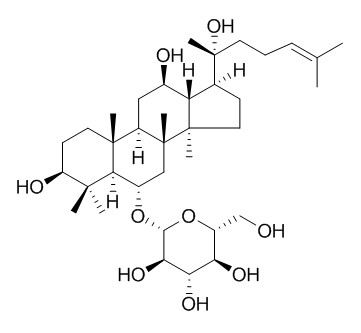(20R)-Ginsenoside Rh1
(20R)-Ginsenoside Rh1 exhibits various pharmacological activities including vasorelaxation, antioxidation, anti-inflammation, and anticancer.
Inquire / Order:
manager@chemfaces.com
Technical Inquiries:
service@chemfaces.com
Tel:
+86-27-84237783
Fax:
+86-27-84254680
Address:
1 Building, No. 83, CheCheng Rd., Wuhan Economic and Technological Development Zone, Wuhan, Hubei 430056, PRC
Providing storage is as stated on the product vial and the vial is kept tightly sealed, the product can be stored for up to
24 months(2-8C).
Wherever possible, you should prepare and use solutions on the same day. However, if you need to make up stock solutions in advance, we recommend that you store the solution as aliquots in tightly sealed vials at -20C. Generally, these will be useable for up to two weeks. Before use, and prior to opening the vial we recommend that you allow your product to equilibrate to room temperature for at least 1 hour.
Need more advice on solubility, usage and handling? Please email to: service@chemfaces.com
The packaging of the product may have turned upside down during transportation, resulting in the natural compounds adhering to the neck or cap of the vial. take the vial out of its packaging and gently shake to let the compounds fall to the bottom of the vial. for liquid products, centrifuge at 200-500 RPM to gather the liquid at the bottom of the vial. try to avoid loss or contamination during handling.
Evid Based Complement Alternat Med.2017, 2017:1583185
Heliyon.2023, e12778.
J Ethnopharmacol.2020, 249:112396
LWT2021, 138:110397.
Aging (Albany NY).2021, 13(19):22867-22882.
Pharmaceuticals (Basel).2021, 14(7):633.
Chemical Engineering Journal2024, 500:157110
Molecules.2017, 22(3)
J Med Food.2021, 24(3):209-217.
J Cell Physiol.2021, 236(3):1950-1966.
Related and Featured Products
Japanese Journal of Pharmacognosy, 1985, 39:123-5.
Pharmacological Study on Panax ginseng C.A. MEYER V. : Effects of Red Ginseng on the Experimental Disseminated Intravascular Coagulation (4). On Ginsenoside-Rg3, Rh1 and Rh2[Reference:
WebLink]
METHODS AND RESULTS:
20S, 20R ginsenoside Rg3, 20S, 20R ginsenoside Rh1, and ginsenoside Rh2 isolated from red ginseng were investigated for their effect on blood platelet aggregation and thrombin-induced conversion of fibrinogen to fibrin in vitro.
CONCLUSIONS:
20S, 20R ginsenoside Rg3 inhibited collagen- and ADP-induced blood platelet aggregation. 20S ginsenoside Rg3, 20S, 20R ginsenoside Rh1 inhibited the thrombin-induced conversion of fibrinogen to fibrin.
Evid Based Complement Alternat Med . 2017;2017:6451963.
Pharmacokinetic Comparison of 20(R)- and 20(S)-Ginsenoside Rh1 and 20(R)- and 20(S)-Ginsenoside Rg3 in Rat Plasma following Oral Administration of Radix Ginseng Rubra and Sheng-Mai-San Extracts[Pubmed:
28620420]
Abstract
Ginsenosides Rh1 and Rg3, as the main bioactive components from Ginseng, are effective for prevention and treatment of cardiovascular diseases. Sheng-Mai-San (SMS), a classical complex prescription of traditional Chinese medicines, is composed of Radix Ginseng Rubra, Fructus Schisandrae, and Radix Ophiopogonis. In this research, a sensitive and specific liquid chromatography-mass spectrometric method was developed and validated for stereoselective determination and pharmacokinetic studies of 20(R)- and 20(S)-ginsenoside Rh1 and 20(R)- and 20(S)-ginsenoside Rg3 epimers in rat plasma after oral administration of Radix Ginseng Rubra or SMS extracts. The main pharmacokinetic parameters including Tmax, Cmax, t1/2, and AUC were calculated by noncompartment model. Compared with Radix Ginseng Rubra, SMS could significantly increase the content of ginsenosides Rh1 and Rg3 in the decocting process. Ginsenosides Rh1 and Rg3 following SMS treatment displayed higher Cmax, AUC(0-t), and AUC(0-∞) and longer t1/2 and tmax except for 20(R)-Rh1 in rat plasma. The results indicated SMS compound compatibility could influence the dissolution in vitro and the pharmacokinetic behaviors in vivo of ginsenosides Rh1 and Rg3, suggesting pharmacokinetic drug-drug interactions between ginsenosides Rh1 and Rg3 and other ingredients from Fructus Schisandrae and Radix Ophiopogonis. This study would provide valuable information for drug development and clinical application of SMS.
Zhongguo Zhong Yao Za Zhi. 2013 Nov;38(22):3910-7.
Chemical constituents from processed rhizomes of Panax notoginseng.[Pubmed:
24558875]
METHODS AND RESULTS:
To investigate the chemical constituents of the processed rhizomes of Panax notoginseng, their 70% ethanol extract was chromatographed on macroporous resin (SP825), silica gel, RP-C18 and semi-preparative HPLC to afford compounds 1-23. On the basis of physicochemical properties and spectral data analysis, their structures were identified to be 6'-O-Acetylginsenoside Rh1 (1), ginsenoside RK3 (2), ginsenoside Rh4 (3), 20S-ginsenoside Rg3 (4), ginsenoside Rk1 (5), 20R-ginsenoside Rg3 (6), ginsenoside Rg5 (7), ginsenoside F2 (8), 20S-ginsenoside Rh1 (9), (20R)-Ginsenoside Rh1(10), gypenoside X VII (11), notoginsenoside Fa, (12), ginsenoside Ra3 (13), ginsenoside Rg1 (14), ginsenoside Re (15), notoginsenoside R2 (16), ginsenoside Rg2 (17), notoginsenoside R1 (18), ginsenoside Rd (19), ginsenoside Rb1 (20), notoginsenoside D (21), notoginsenoside R4 (22) and ginsenoside Rb2 (23), respectively. Among them, compound 1 was isolated from P. notoginseng for the first time, and compounds 4, 6, 8 and 11 were isolated from the processed P. notoginseng for the first time.
CONCLUSIONS:
According to the fingerprint profiles of raw and processed P. notoginseng, the putative chemical conversion pathways of panoxatriol and panoxadiol compounds in the processing procedure was deduced, and the results revealed the main reactions to be dehydration and glycosyl hydrolysis.



